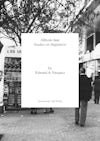Content
In 1967, Richard Long, then a student at St. Martin’s School of Art in London, walked back and forth along a straight line in the grass in the English countryside, leaving a track that he then photographed in black and white. This work, A Line Made by Walking, was not only the starting point for Long’s career as an artist, but also a landmark for a new kind of art emerging in Europe and the Americas.
In this critical study, Dieter Roelstraete explores how the work’s location outside the gallery context and its suggestion of bodily action makes it characteristic of the work made by a new generation of artists who combined the organic, the temporary, the non-material and the performative to offer a critique of the art system and its language, forms and values.
Erratum: On page 61, plate 18, the wrong illustration and title were used to refer to a work by Keith Arnatt, which consists of a series of nine photographs showing the artist facing the camera, and progressively disappearing into the ground. The artwork, part of Tate Collection, is titled Self-Burial (Television Interference Project) , from 1969 . The photographs are mounted on board, and displayed on a square grid. They measure 467 x 467mm each (unframed) or 474 x 473mm (framed). On page 54, the text should also refer to Self-Burial (Television Interference Project).




